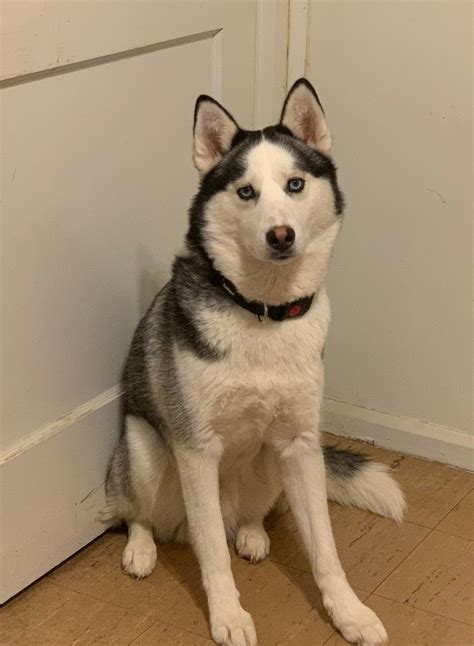
A husky’s exuberant reaction to finally meeting his 10-month-old baby sister has captured hearts online, showcasing a touching display of canine affection and marking a long-awaited introduction.
The joyous moment, documented in a now-viral video, shows the husky, named Tofu, overcome with excitement as he is carefully introduced to the infant. For months, the family had kept the two separated, prioritizing the baby’s safety and well-being. However, the carefully planned first encounter proved to be a resounding success, resulting in a heartwarming display of canine enthusiasm that resonated with viewers worldwide.
“We were very cautious about the first meeting,” explained the baby’s mother, capturing the calculated approach undertaken by the parents. “We wanted to make sure both were safe and comfortable.” This caution stemmed from a deep understanding of canine behavior and the potential risks associated with introducing a large dog to a vulnerable infant. The parents meticulously planned the encounter, ensuring a controlled and supervised environment to mitigate any potential issues.
The video, posted on social media, quickly gained traction, amassing millions of views and sparking widespread commentary. Viewers expressed admiration for the husky’s gentle nature and the family’s responsible approach to the introduction. The clip serves as a powerful reminder of the strong bonds that can exist between humans and animals, and the joy that pets can bring to family life. It also highlights the importance of carefully managing interactions between pets and young children, prioritizing safety and gradual acclimatization.
The family had been preparing Tofu for the arrival of his new sibling for months, using various techniques to acclimate him to the sights, sounds, and smells associated with a baby. This included playing recordings of baby cries, introducing baby-related items, and gradually exposing him to the baby’s scent through clothing and blankets. These efforts were aimed at minimizing any potential anxiety or jealousy and fostering a positive association with the new addition to the family.
Tofu’s reaction in the video is a testament to the success of these preparations. As the baby sister is brought closer, Tofu can be seen wagging his tail vigorously, jumping with excitement, and showering the infant with gentle nudges and licks. The interaction is closely supervised by the parents, who ensure that the baby remains safe and comfortable throughout the encounter.
The family hopes that their experience will inspire other pet owners to approach similar situations with caution, patience, and a focus on safety. They emphasize the importance of understanding canine behavior and taking proactive steps to minimize any potential risks. They also highlight the rewards of successful integration, as pets can bring immense joy and companionship to families with young children.
Understanding the Husky Breed
Huskies, known for their striking appearance and energetic nature, are a popular breed, but understanding their specific traits is crucial before introducing them to young children. Originally bred as sled dogs in harsh Arctic environments, huskies possess a strong prey drive and a pack mentality. While generally friendly and affectionate towards humans, their high energy levels and inherent instincts require careful management, especially around infants.
Huskies thrive on routine and consistent training. Their independent nature necessitates firm and patient guidance to establish clear boundaries and ensure obedience. Without proper training and socialization, huskies can exhibit destructive behaviors or become overly excited, potentially posing a risk to young children.
Their thick double coat, designed to withstand extreme cold, also requires regular grooming to prevent matting and shedding. This grooming process can be an opportunity to bond with the dog and reinforce positive interactions.
Preparation is Key:
The family in the news story emphasized the importance of preparing Tofu for the arrival of the baby. This involved several key strategies:
- Scent Introduction: Before the baby came home, the parents introduced Tofu to the baby’s scent by bringing home blankets and clothing that had been used by the infant. This allowed Tofu to familiarize himself with the new scent and associate it with positive experiences.
- Sound Acclimation: Playing recordings of baby cries and other infant-related sounds helped Tofu adjust to the new noises that would be present in the household. This prevented him from becoming startled or anxious when the baby cried.
- Visual Exposure: Gradually introducing Tofu to baby-related items, such as strollers, cribs, and toys, allowed him to become accustomed to the new objects and prevent him from viewing them as threats or sources of competition.
- Controlled Interactions: The first meeting was carefully planned and supervised. The parents ensured that Tofu was calm and relaxed before introducing him to the baby. They also kept the interaction brief and closely monitored Tofu’s body language for any signs of stress or anxiety.
Expert Advice on Introducing Pets to Babies:
Veterinarians and animal behaviorists recommend a multi-faceted approach to introducing pets to babies, emphasizing safety, gradual acclimatization, and positive reinforcement.
- Never leave a pet unsupervised with a baby: This is the most important rule. Even the most well-behaved pet can react unpredictably, especially in a novel situation. Constant supervision is crucial to ensure the safety of both the baby and the pet.
- Create a safe space for the pet: The pet should have a designated area where it can retreat and relax without being disturbed by the baby. This provides the pet with a sense of security and prevents it from feeling overwhelmed.
- Associate the baby with positive experiences: Reward the pet with treats and praise when it behaves calmly and gently around the baby. This reinforces positive associations and encourages the pet to view the baby as a source of positive reinforcement.
- Teach the pet basic obedience commands: A well-trained pet is easier to manage and control. Basic commands such as “sit,” “stay,” and “leave it” can be invaluable in ensuring the baby’s safety.
- Be patient and consistent: It takes time for a pet to adjust to a new baby. Be patient and consistent with your training and socialization efforts. Avoid forcing interactions and allow the pet to approach the baby at its own pace.
- Consult with a veterinarian or animal behaviorist: If you are experiencing difficulties introducing your pet to your baby, consult with a veterinarian or animal behaviorist for personalized guidance. They can assess your pet’s behavior and provide tailored recommendations to ensure a safe and successful integration.
- Safe Zones and Boundaries: Designating specific “safe zones” for the dog, such as a crate or bed, where the baby is never allowed to intrude, is crucial. This provides the dog with a retreat where it can relax without feeling threatened. Establishing clear boundaries, such as teaching the dog to stay away from the baby’s play area, further minimizes potential risks.
The Viral Video’s Impact:
The viral video of Tofu meeting his baby sister has resonated with viewers for several reasons:
- Heartwarming Content: The video captures a genuine and touching moment of connection between a dog and a baby. This type of content is inherently appealing and evokes positive emotions in viewers.
- Relatability: Many pet owners can relate to the challenges and joys of introducing a pet to a new baby. The video provides a glimpse into this experience and offers hope that a successful integration is possible.
- Positive Message: The video promotes responsible pet ownership and highlights the importance of careful planning and supervision when introducing pets to young children.
- Social Media Sharing: The video’s heartwarming content and positive message make it highly shareable on social media platforms, contributing to its rapid spread and widespread viewership.
- Inspiring others: This story has influenced many people to adopt or rescue animals knowing that most of the time, they can be very loving and caring to little ones.
The Importance of Responsible Pet Ownership
The story of Tofu and his baby sister underscores the significance of responsible pet ownership. Bringing a pet into a family is a significant commitment that requires careful consideration and planning. Pet owners must be prepared to provide for the animal’s physical, emotional, and social needs. This includes providing proper nutrition, exercise, veterinary care, training, and socialization.
Responsible pet ownership also involves taking steps to ensure the safety of both the pet and the people around it. This includes properly training the pet, supervising its interactions with children, and taking precautions to prevent bites or other injuries.
Beyond the Viral Moment:
While the viral video offers a snapshot of a positive interaction, it is important to remember that the integration process is ongoing. The family will need to continue to monitor Tofu’s behavior and provide consistent training and socialization to ensure that he remains comfortable and safe around his baby sister as she grows.
This includes:
- Continued Supervision: Even as the baby gets older, it is important to continue to supervise interactions between Tofu and the baby. This will help prevent any accidents or misunderstandings.
- Positive Reinforcement: Continue to reward Tofu for behaving calmly and gently around the baby. This will reinforce positive associations and encourage him to continue to view the baby as a source of positive reinforcement.
- Adaptation to Changing Dynamics: As the baby grows and becomes more mobile, the dynamics between Tofu and the baby will change. The family will need to adapt their approach accordingly to ensure that both remain safe and comfortable.
- Professional Guidance: Seeking guidance from a qualified dog trainer or animal behaviorist can be valuable in navigating the challenges of integrating a dog and a baby.
Conclusion:
The story of Tofu and his baby sister is a heartwarming reminder of the strong bonds that can exist between humans and animals. It also highlights the importance of responsible pet ownership, careful planning, and consistent training when introducing pets to young children. By following these guidelines, families can create a safe and harmonious environment where both pets and children can thrive. The video serves as an inspiration to pet owners around the world, demonstrating the potential for positive and loving relationships between animals and children. It underscores that with proper preparation and understanding, pets can indeed become cherished members of the family, enriching the lives of everyone involved. The positive reaction of the husky, Tofu, emphasizes the crucial role of careful planning and responsible pet ownership in ensuring the well-being of both the child and the animal.
Frequently Asked Questions (FAQ):
1. What breed of dog is Tofu, and what are some common characteristics of this breed that owners should be aware of when introducing them to babies?
Tofu is a husky. Huskies are known for their high energy levels, strong prey drive, and pack mentality. They require consistent training and socialization to ensure they are well-behaved around children. Owners should be aware of their potential for exuberance and the need for structured interactions to prevent accidental injuries. Huskies also need a lot of exercises which can be time consuming.
2. What specific steps did the family take to prepare Tofu for the arrival of the baby, and why are these steps considered important for a successful introduction?
The family implemented several strategies, including scent introduction (using blankets and clothing), sound acclimation (playing baby cries), and visual exposure (introducing baby-related items). These steps are important because they help the dog familiarize itself with the new sights, sounds, and smells associated with the baby, reducing anxiety and promoting a positive association.
3. The article mentions the importance of supervision when pets and babies interact. Can you elaborate on what responsible supervision looks like in practice and why it is essential?
Responsible supervision means actively monitoring the pet’s body language and behavior during interactions with the baby, ensuring that the pet is calm and relaxed. It also involves maintaining physical control, such as keeping the pet on a leash or in a confined area, and never leaving the pet and baby alone together. Supervision is essential because even well-behaved pets can react unpredictably, and it allows for immediate intervention if any potential problems arise. Even the most docile of dogs might accidentally hurt a baby.
4. What are some potential warning signs that a pet is not adjusting well to a new baby, and what steps should owners take if they observe these signs?
Warning signs may include excessive barking or whining, hiding or avoiding the baby, growling or snapping, changes in appetite or sleep patterns, and destructive behaviors. If these signs are observed, owners should immediately separate the pet and baby, consult with a veterinarian or animal behaviorist, and implement a more gradual and controlled introduction process.
5. The article touches on creating “safe zones” for the pet. Can you explain what a safe zone is, how it benefits the pet, and some practical ways to establish one within the home?
A safe zone is a designated area, such as a crate, bed, or room, where the pet can retreat and relax without being disturbed by the baby or other family members. This provides the pet with a sense of security and control, preventing it from feeling overwhelmed or threatened. Practical ways to establish a safe zone include choosing a quiet location, making the area comfortable and inviting, and ensuring that the baby is never allowed to enter or disturb the pet in its safe zone. It also allows the dog to have some time to themselves to relax.









